Abstract: Cherry production is characterized by a very short fruit development period that covers an average of 80 days from flowering to harvest. Although there are varieties with different cycles, the harvest in Alto Valle de Río Negro and Neuquén, Argentina, is highly concentrated. The possibility of extending the harvest period allows to improve logistics, decongest packing work and regulate to a certain extent the supply of cherries on the market. Fruit cherries are highly perishable non-climacteric fruits and have low supply in counter season, which determines an unsaturated foreign market and the possibility to obtain good prices. The highest prices on the market depend on the fruit size and fruit quality and the harvest time (early and late). The aim of this work was to evaluate the feasibility of using different growth regulators and bio-stimulants to extend the sweet cherries harvest period. The use of hydrogen cyanamide (hc) in early varieties to advance the harvest and the use of Retard Cherry® (rch) in late varieties to delay flowering and harvesting were evaluated. In addition, the effect of gibberellins (Gb) on the delay of maturity and improvement in quality in different varieties was evaluated. The use of hc allowed to advance bloom by 10 days and the harvest by 7 days in fruits of New Star, while rch delayed the bloom (10 days) and maturity (5 days) of Santina, Lapins and Regina cherries. The application of Gb at 20 ppm from straw yellow stage until the start of the pink improves the quality of the fruits, but the effect on delaying maturity decreases with later applications. The use of regulators in cherries allows to extend the harvest window in nearly 10 days, depending on each cultivar and the meteorological conditions of the season.
Keywords: hydrogen cyanamide, gibberellins, bio stimulants, New Star, Sweetheart, Regina.
Resumen: La producción de cerezas se caracteriza por un ciclo productivo corto que abarca un promedio de 80 días desde floración a cosecha. Si bien existen variedades de diferentes ciclos, la cosecha en el Alto Valle de Río Negro y Neuquén, Argentina, es muy concentrada. El escalonamiento de la cosecha ayuda a mejorar la logística, descongestionar el trabajo en los empaques y regular en cierta medida la oferta de cerezas en el mercado. La cereza es un fruto de corta conservación y baja oferta en contraestación, lo que determina un mercado externo no saturado y la obtención de buenos precios. Los mayores precios en el mercado dependen del calibre y la calidad de las cerezas y del momento de la temporada de cosecha (primicia y tardicia). El objetivo de este trabajo fue evaluar la factibilidad de uso de regladores de crecimiento como estrategia para extender el período de cosecha de cerezas. Se evaluó el uso de cianamida hidrogenada (hc) en cultivares tempranos para adelantar la cosecha y el uso de Retard Cherry® (rch) en cultivares tardíos para retrasar la floración y la cosecha. Además, se evaluó el efecto de las giberelinas (Gb) en el retraso de madurez y mejora en la calidad en diferentes cultivares. El uso de hc logró adelantar 10 días la floración y 7 días la cosecha en New Star, mientras que el rch retrasó la floración (10 días) y la madurez (5 días) de cerezas Santina, Lapins y Regina. La aplicación de Gb a 20 ppm desde color pajizo hasta inicio pinta mejora la calidad de los frutos, pero el efecto en el retraso de la madurez disminuye con aplicaciones más tardías. El uso de reguladores en cerezas permite ampliar la ventana de cosecha en alrededor de 10 días dependiendo de cada cultivar y las condiciones de la temporada.
Palabras clave: cianamida hidrogenada, giberelinas, bioestimulantes, New Star, Sweetheart, Regina.
Resumo: A produção de cerejas é caracterizada por um curto ciclo de produção, que abrange, em média, 80 dias desde a floração até a colheita. Embora existam variedades de ciclos diferentes, a colheita no Alto Valle de Río Negro e Neuquén, Argentina é altamente concentrada. O escalonamento da colheita ajuda a melhorar a logística, descongestionar o trabalho de embalagem e, até certo ponto, regular o fornecimento de cerejas no mercado. A cereja é um fruto de curta conservação e baixa oferta na contra-estação, o que determina um mercado externo insaturado e a obtenção de bons preços. Os preços mais altos do mercado dependem do calibre e qualidade das cerejas e da época da colheita (precoce ou tardia). O objetivo desse trabalho foi evaluar a possibilidade de uso de reguladores de crescimento como estratégia para estender o período de colheita de cerejas. Foram avaliados o uso de cianamida hidrogenada (HC) em cultivares precoces para adiantar a colheita e o uso de Retard Cherry® (RCH) em cultivares tardias para retardar o florescimento e a colheita. Além disso, foi avaliado o efeito das giberelinas (Gb) no retardamento da maturação e na melhoria da qualidade em diferentes cultivares. O uso de HC conseguiu adiantar a floração em 10 dias e a colheita em 7 dias, em 'New Star', enquanto o RCH atrasou a floração (10 dias) e a maturação (5 dias) das cerejas 'Santina', 'Lapins' e 'Regina'. A aplicação de Gb a 20 ppm quando as frutas estão na cor da palha ao início da rosa, melhora a qualidade dos frutos, mas o efeito no atraso da maturidade diminui com aplicações mais tardias. O uso de reguladores em cerejas permite estender a janela da colheita em cerca de 10 dias, dependendo da cultivar e das condições da estação.
Palavras-chave: cianamida hidrogenada, giberelinas, bioestimulantes, New Star, Sweetheart, Regina.
Physiology, propagation and new technologies
Tools to modify cherries harvest time in Alto Valle de Río Negro and Neuquén, Argentina
Herramientas para regular el momento de cosecha en cerezas en el Alto Valle de Río Negro y Neuquén, Argentina
Ferramentas para regular o tempo de colheita em cerejas no Alto Valle de Río Negro e Neuquén, Argentina
Received: 17 July 2020
Accepted: 10 August 2020
Published: 06 April 2021
Corresponding author: raffo.dolores@inta.gob.ar

Sweet cherry (Prunus avium L.) ripens first among stone fruits, followed by apricot, peach and plum. Because sweet cherry is first on the fresh market, it is highly demanded in late spring and early summer. Cherry production is characterized by a very short fruit development period (fdp) that covers an average of 80 days from bloom to harvest. Although there are cultivars with different cycle lengths, the harvest time in our region is highly concentrated(1). The possibility of extending the harvest period helps to improve logistics, decongest packing activities and regulate —to a certain extent— the supply of cherries on the market. Cherries are highly perishable fruits and have a short cold storage period and low supply in counter season, conditions that determine an unsaturated external market and thus the possibility to obtain good prices. The highest prices on the market depend on the size and quality of the cherries and the harvest period (early and late)(2). The use of growth regulators may allow to advance or retard the time of harvest aiming to improve logistics and labour efficiency, decongest packaging and also reaching the market when the prices are the highest. In cherries, budburst and flowering were advanced and yield increased with the application of hydrogen cyanamide (Dormex®) prior to budburst in the field(3). Ripening advancement of 7 to 8 days was observed in Burlat, and of 7 to 9 days in Ferrovia(4). On the other hand, Retard Cherry® is a liquid bio stimulant that was used in Chile to delay bloom, avoid frost damage and also allows delaying the harvest by 3 to 5 days, enabling the farmer to stagger the harvest and optimizing the use of labour(5). Gibberellic acid (ga3) application is a standard commercial practice during sweet cherry production to increase the fruit size and soluble solids concentration. It is used to delay harvest and increase fruit firmness, being applications of 20 ppm at the straw-color stage the common recommendation(6)(7)(8).
The aim of this work was to evaluate the feasibility of using hydrogen cyanamide, bio stimulants and gibberellins to extend the sweet cherries harvest period.
Trials were performed over three different seasons in an orchard located in Rio Negro, Argentina (39º 02' 24"S y 67º 38' 47" W; 245 m above sea level, 244 mm annual rainfall, 15 ºC annual average temperature). Hydrogen cyanamide trials were performed in 2008-09 season; the bio stimulant trials in 2017-18 and the gibberellins experiments in 2006-07 season.
The use of hydrogen cyanamide (hc) in early varieties to advance the harvest was evaluated. Three treatments were performed 30 days before bud break, each treatment covering 6 trees of New Star sweet cherries: Dormex® 2% (vol/vol), Dormex® 4% and Control (water). Dormex® treatments were applied with commercial surfactant (2%).
The use of Retard Cherry® (rch) was evaluated in Kordia, Regina, Sweetheart and Santina. Five trees of each cultivar were treated with rch (at commercial rate) and five were used as control.
The effect of gibberellins (Gb) on the delay of maturity and improvement in quality in New Star was evaluated. Three treatments were tested: GA3 20 mg·L-1 at start of veraison (30% straw yellow coloration); at veraison (60% straw yellow skin color); and at control. Each treatment covering four trees.
In trials 2.1 and 2.2, phenology was recorded twice a week following the method of Baggiolini(9).
In all trials, a sample of 100 fruit per treatment was randomly collected, in each harvest date, for evaluations of fruit quality. Fruit weight was determined using digital scales (Sartorius, Germany) and fruit firmness with a Durofel device (Durometer, Shore A). Total soluble solids content was determined on the fruit juice with a digital refractometer (Atago CO., Ltd.). Fruit juice was also analyzed for total titratable acidity using 0.1 N NaOH to pH 8.2. Skin color was classified using a Color Chart (eea Alto Valle inta, Post-harvest Area), into six color categories designated from 1 to 6. Skin color and soluble solids content are the main criteria used to judge fruit maturity. We used values between 2 and 3 as the optimal color for New Star harvest, and values between 6-20°Brix for New Star and 20-21°Brix for sweetheart.
Data were analyzed by analysis of variance (anova) with the statistical software Infostat (Universidad Nacional de Córdoba, Argentina). Means were compared using the lsd Fisher test.
Dormex® treatments applied 30 days before the average flowering date promoted initial bloom eleven days earlier at concentration of 4% and five days earlier at 2%, compared to the control treatment. Thus, the effect increased with higher Dormex® dose (Figure 1), in accordance with previous reports(10), which observed a maximum advancement of bloom of 11 to 13 days in Burlat and 7 to 9 days in Ferrovia. In addition, in comparative studies carried out on cherries with three active ingredients, the hc consistently gave the most accelerated blooming(11). Application of 2.5% hc also resulted in a marked increase in bud-break rate compared to control samples in Vitis vinifera L.(12).
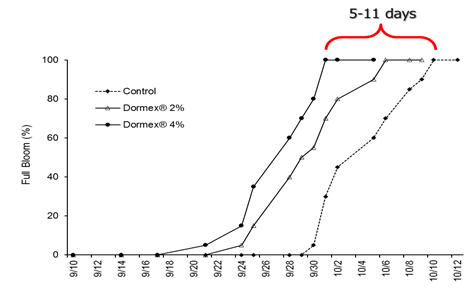
Both Dormex® treatments advanced New Star maturity, achieving the earliest harvest with Dormex® at 4%.
Consumers are first attracted by color, while fruit sweetness is the second decisive criterion for quality. Dormex® at 4% achieved optimal sugar standards and color intensity for harvest, one week earlier than the other treatments (Table 1 and Figure 2). In contrast, previous reports found no effect on soluble solids of Bing cherries that had been treated with label rates of hc(13). Probably due to climatic conditions between dates of application and fruit ripening(10).
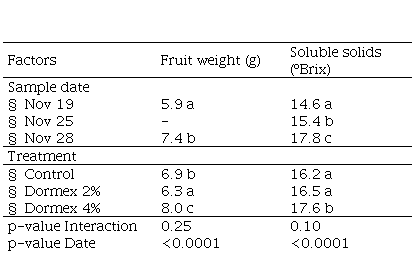
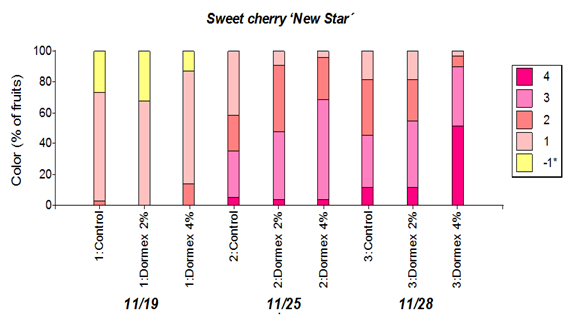
Three days after the first harvest (Nov 28), 90% of fruit from the Dormex® 4% treatment showed appropriated color to be collected (color categories 2, 3 and 4), but only 45% of the control fruits were in these color categories (Figure 2). As previously reported, full skin color assure a large number of fruit with minimum soluble solids content(14).
The advancement in fruit maturity with Dormex® treatments was less than that observed in bloom, as reported before(4)(10). Consequently, Dormex® at 4% applied to early-ripening cultivars allowed an early harvest and may improve grower profits by reaching markets before prices drop.
Retard Cherry® application in the fall of 2018 caused a delay in flowering of 7 to 10 days in all evaluated cultivars (Figure 3). Autumn treatments with Retard Cherry® were effective in delaying the leafing, flowering and ripening of Santina, Sweetheart, Regina and Kordia cherries. The same tendency was observed in tests carried out in the vii Region in Chile with Retard Chery® applications, where a delay of 7-12 days in full bloom was observed in the cultivars Lapins, Sweetheart, Kordia and Regina(5).
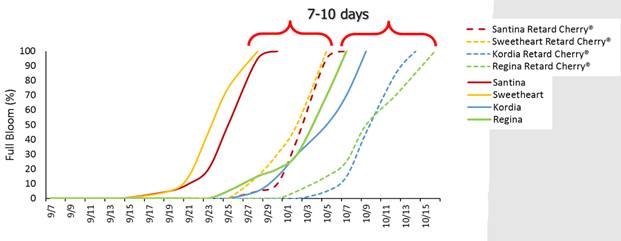
*Each value represents the average of five trees per treatment. Solid lines indicate control and dashed ones’ RCH treatment in each variety
In Sweetheart, fruits treated with Retard Cherry® showed a marked delay in color development. On December 3rd sample, 35% of fruits of the control plants presented an average skin color classified as 3, while in those treated samples, 100% of the fruits had an average skin color below 2. Also fruits from control treatments were able to be harvested in December 10 (Figure 4). The same results were observed in the other cultivars (data not shown).
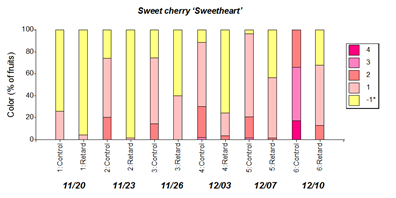
Gibberellins application significantly increased the average fruit size, without showing differences between the two application moments (Table 2) in contrast to other previous study(11). Likewise, it agrees with studies in Bing, where it was determined that ga3 applications were effective in increasing the fruits size when applied in stage II and III of the growth curve(15). Regarding firmness, although a gradual increase was observed as application time was delayed (5.8% and 11.5%), no statistically significant differences were found between the two ga3 applications (Table 2). This concurs with findings from other studies where ga3 applications allowed harvest delay while maintaining acceptable firmness in different cultivars(6)(7)(11)(16). Also, other reports showed that ga3 treated sweet cherry fruit were significant firmer than those of the control at harvest time, and this firmness was better maintained than the control after storage(7). The latest treatment with gibberellins caused an increase in the soluble solids content with an average value of 20.5 ºBrix, while the control had a value of 17.9 ºBrix (Table 2). An increase in firmness without a delay in the increase of soluble solids content is desirable. Same response was found in titratable acidity, with the later treatment of gibberellins showing the highest value respect to other treatments (Table 2). In contrast, soluble solids and titratable acidity did not vary with respect to ga3 treatment, but did with respect to year(11). As previously reported(6)(7)(17) treatments of 20 mg L-1 of ga3 present better results in terms of fruit quality at harvest and post-harvest; and a positive relationship between ga3 applications and fruit quality parameters such as firmness, weight and soluble solids was observed. As previously reported, rate of accumulation of fruit soluble solids was similar for treated and non-treated fruit. So fruit soluble solids content could have been similar or higher, depending on the delay of harvest(16). Although titratable acidity plays a role in consumers acceptance, the importance of its measurement is less relevant than soluble solids, because soluble solids changes are greater during the cherry ripening period.

Fruit skin color is often the basis for timing of commercial sweet cherries harvest, and ga3 preharvest applications delays color development of New Star sweet cherries, regardless the time of the treatment application (Figure 5).
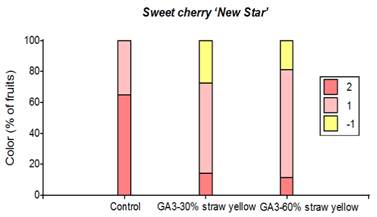
Hydrogen cyanamide proved to be an effective dormancy-breaking agent in sweet cherries. Thus, in regions with average chilling hours of 1.200 hydrogen cyanamide applications are recommended for early cultivars to advance maturity.
Retard Cherry® applications were effective in delaying the leafing, flowering and ripening of sweet cherries.
Moreover, ga3 treatment allowed harvest delay while maintaining acceptable firmness. Also, delaying maturity may lengthen the growing season, allowing fruit to remain on the tree longer so that its size may increase.
The use of different growth regulators allows the advancement and delay of bloom date in ± 10 days, and the advancement or delay of fruit ripening to a lesser extent (5-7 days). Thus, their use allows to extend the harvest window in around 10-17 days, depending on each cultivar and meteorological conditions of the season.
Author
contribution statement: All authors contributed equally to
the content.
Editors: The following editors approved this
article.
Maximiliano Dini (https://orcid.org/0000-0003-1118-7803)
Instituto Nacional de Investigación
Agropecuaria (INIA), Canelones, Uruguay.
Roberto Zoppolo
(https://orcid.org/0000-0003-3063-0196)
Instituto Nacional de Investigación
Agropecuaria (INIA), Canelones, Uruguay.
http://agrocienciauruguay.uy/ojs/index.php/agrociencia/article/view/401/699 (pdf)
This research was supported by inta Project. The technical assistance of Fernando Roma is greatly appreciated.
raffo.dolores@inta.gob.ar




*Each value represents the average of five trees per treatment. Solid lines indicate control and dashed ones’ RCH treatment in each variety




